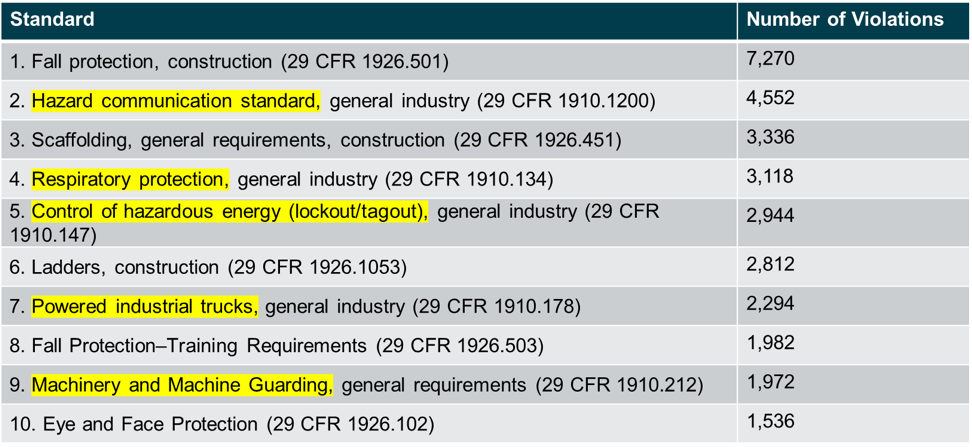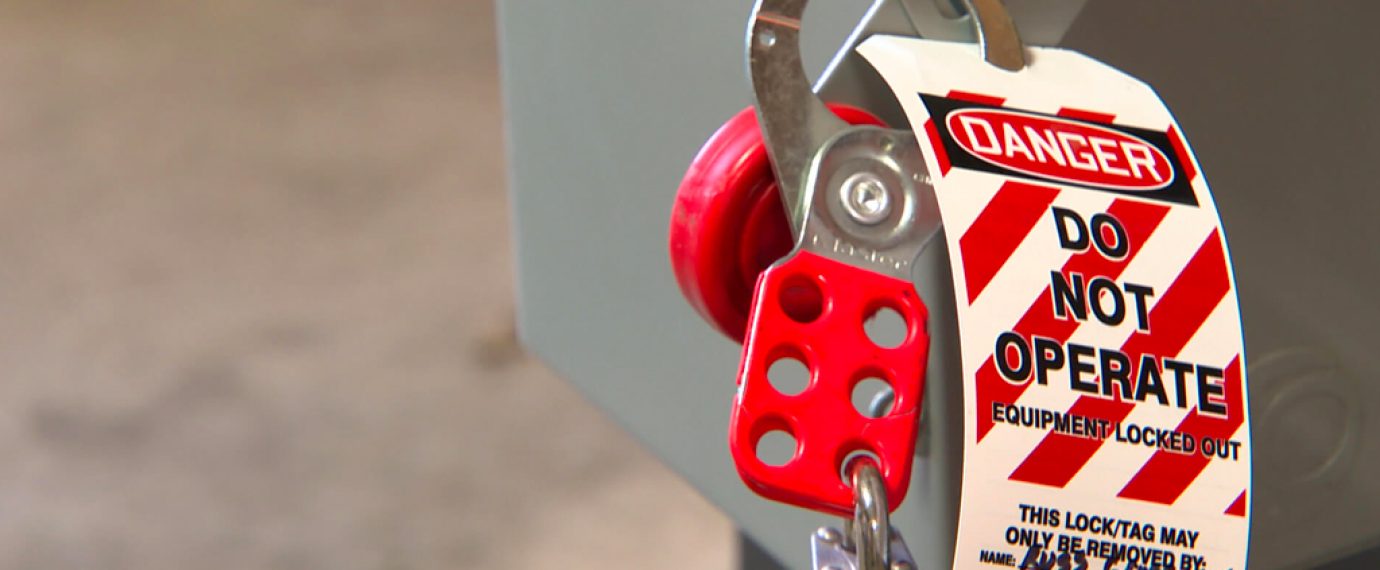It’s the phone call every safety, plant or human resource manager dreads: “There’s someone from OSHA here waiting for you in the lobby.”
Regulatory action isn’t the sole reason we work every day on our safety programs, but it does create an instance where the “rubber meets the road” so to speak. Being able to see your facility through the eyes of a regulatory inspector enables you to recognize potential issues and implement corrective actions to provide a safer workplace. It also helps you quickly and painlessly handle an inspection without having to open the checkbook.
So how can you look at your site through the eyes of an OSHA inspector?
One technique is to utilize the data OSHA provides to the general public. On an annual basis, OSHA releases the list of regulations most frequently cited during on-site facility inspections the previous calendar year. It is a valuable exercise to review the most common violations, how they apply to your facility, and if there is anything you need to do to reduce your organizational risk.
For FY2018, OSHA has provided the following list:

In the chart above, we have highlighted those items that pertain to general industry. We’ll focus on these 5 key standards that affect the general industry environment and possibly your facility. Knowing and understanding the requirements related to these items and what an inspector will be looking for will help you prepare for an OSHA inspection and get that inspector out the door faster.
Hazard Communication Standard, General Industry (29 CFR 1910.1200)
Year after year, the hazard communication standard occupies the top general industry spot on this list. Why? Because issues related to hazard communication are easy to spot. Here are some key requirements under the hazard communication standard:
- A Site-specific Written Program – No general corporate-speak allowed! Your written program must be specific, not just to your overall organization, but to your site location. Your program must:
- Outline your chemical labeling system.
- Outline a procedure for identifying hazards and training employees to conduct non-routine tasks.
- Outline Safety Data Sheet (SDS) locations, access, and a maintenance/update schedule.
- Contain a complete chemical inventory list as well as identify the related hazards from those chemicals.
- Have a developed and followed site-specific training process.
- Documented Training –Training for hazard communication is required for an employee initially upon hire, when a new hazard or chemical is introduced, and periodically thereafter.
- Compliant Labeling – As outlined above, compliant labeling is required for all containers. As part of the 2012 update to this standard, OSHA implemented the Globally Harmonized System for labeling that includes the following requirements:
- Product Identifier
- Signal Word (Warning or Dangerous)
- Pictogram
- Hazard Statement
- Precautionary Statement
- Access to compliant Safety Data Sheets (SDS) – All employees must be able to access an SDS at any time without having to ask for permission.
Respiratory Protection (29 CFR 1910.134)
Inhalation is the most common and “easiest” route of entry into the body for potentially hazardous materials. Oftentimes employees will unknowingly bring in respirators from home or other sites that are missing key aspects required under the respiratory protection standard. Air quality concerns are also one of the most common complaints from employees that can lead to an OSHA inspection.
The mandatory use of respirators requires a site-specific respiratory protection program that incorporates the following aspects:
- Medical Evaluations – Required for mandatory usage or for voluntary use of tight-fitting respirators at the initial assignment and periodically thereafter, based on physician or other licensed health care professional (PLHCP) recommendations, or if medical status or workplace conditions change.
- Maintenance and Care – Must be kept in a closed container, maintained in good condition and kept clean.
- Fit Testing Procedures – Required to be conducted annually.
- Emergency Use – Required to be inspected monthly.
- Cartridge Change Out Policy – How often respirator cartridges must be changed must be established by the employer. The process can be a bit challenging and is based on a variety of factors including but not limited to work rate, chemical presence amount, temperature, and humidity.
If voluntary respirators are used, Appendix D of the 1910.134 standard must be provided prior to use and a signed copy for each participating employee must be available. Documented industrial hygiene monitoring is required to show the ability to allow for voluntary use.
Control of Hazardous Energy (lockout/tagout) (29 CFR 1910.147)
The control of hazardous energy, commonly referred to as lockout/tagout, is a necessary and lifesaving component of maintenance, servicing, cleaning, and setting up equipment. If your livelihood (your hands) are going to be in a piece of equipment, you must be protected. Here are some key elements of a compliant lockout/tagout program:
- Site-Specific Written Program – Include procedures, equipment, and a breakdown of authorized and affected level employees.
- Documented Machine-Specific Procedures – For all types of equipment.
- Periodic Inspections – Required on an annual basis for all authorized employees and each similar pieces of equipment they service.
- Employee Training at Two Levels:
- Authorized Level Employees – Initially upon hire, whenever changes are introduced, and periodically thereafter.
- Awareness Level Employees – Initially upon hire, whenever changes are introduced, and periodically thereafter.
Facilities should ensure authorized employees are fluent in lockout/tagout and have adequate equipment and materials to complete lockout/tagout properly each and every time it is required.
Powered Industrial Trucks (29 CFR 1910.178)
Powered Industrial Trucks (PIT), or lift equipment, are vital cogs for any facility. They also weigh at least double a standard car and are to only be operated by trained employees. Failure to completely and properly train PIT operators is the most notable issue with PIT violations. A proper operator certification includes the following elements:
- Formal instruction including a written and graded examination.
- A practical (hands-on) training on the site and lift equipment specifics.
- A performance evaluation where the employee demonstrates their skill and understanding of the safe driving techniques learned through the training process.
This training regimen is to be completed before an operator is permitted to drive a PIT. Any operator involved in an accident, near miss, or observed driving unsafely shall be retrained. If new equipment or new hazards are introduced, an operator’s training should be extended. Refresher training is required every three years and the requirements focus on the performance evaluation.
PIT inspections must be performed for each piece of lift equipment at the start of every shift. For those facilities utilizing fuel burning lift equipment, such as liquefied petroleum/propane, an evaluation of carbon monoxide levels is required.
Machinery and machine guarding, general requirements, (29 CFR 1910.212)
Machine guarding is a complex and involved topic that is unique for every individual piece of equipment. But one thing is certain – no machine should ever be operated with its guard removed. When evaluating your site, start with common equipment such as the following:
- Grinding wheels
- Mills
- Lathes
- Power Presses
- Shears
- Power saws
- Portable tools such as angle grinders
Often this equipment will come with guards already installed or available and should be utilized according to manufacturer’s specifications. Certain specific equipment, such as woodworking tools and mechanical power presses, have specific OSHA standard requirements. The American National Standards Institute (ANSI) also creates machine-specific guidance on items like shears and presses. All equipment must have guarding of moving parts in accessible areas below 7 feet as well as for the point of operation – the location where the work is being done. This work includes activities such as cutting, shaping, boring, grinding or forming areas. Finally, any equipment designed for a fixed location must be anchored (bolted to the floor) to prevent walking or moving.
Surviving an OSHA Inspection Unscathed
When looking at the big heavy book of OSHA regulations, the idea of surviving an OSHA inspection unscathed can seem impossible. However, by starting with what is most commonly found, an impossible task doesn’t feel so daunting. By attacking the most common citations first, we can take an important step in providing a safer and more compliant workplace.
If you need additional assistance with attending to OSHA’s common violations, contact U.S. Compliance. We provide safety, health and environmental services to hundreds of facilities in the manufacturing and general industry sector across the country and can help you inspect your facilities as well as develop programs and procedures in the areas reviewed.



